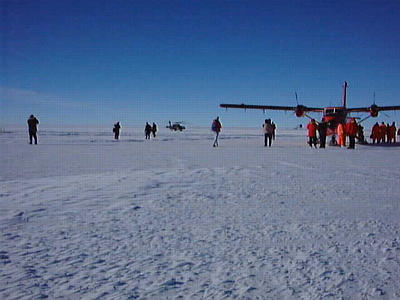28 January, 1999
Thursday, January 28th, 1999, South Pole Station
Greetings to everyone. The temperature is - 28C, with 8knots, sunny
skies, bright sun.
The morning was taken up with answering questions in emails and to
meet Joel for lunch. During the afternoon, I was at ARO to help out
with the general collection of data monitoring CFC's CO2, aerosol, and
total ozone. I am getting better reading the DOBSON for total ozone
but it will take me a while to get faster. Joel is a very good
teacher. We have to do the readings 3 times a day each reading
contains 3 times 2 (6) different readings.
I was often ask by students why the ozone whole closes again after the
month of October. Interesting question and I will discuss that
tomorrow. I will consult the experts again.
During the morning we had a parcticular interesting event - don't we
ever! THE FIRST HELICOPTER EVER ARRIVED HERE AT THE SOUTH POLE. It was
exciting to all of us and we went out to great them and to take
pictures. The helicopter came from Chile and was accompanied by
smaller planes. The first general of Chile and his crew cam to visit
to explore and expand rescue possibilities. I am including in this
journal the official write up we all received here on station from our
station manager, Dave Fisher.
HELICOPETER FLIGHT FROM PUNTA ARENAS TO SOUTH POLE
January 28 at 18:50 hours an UH 60L Black Hawk helicopter from the
Chilean Air Force (FACH) landed at Admundsen Scott Station at the
South Pole. The helicopter flew from Punta Arenas (Chile, South
America), crossing the Drake Passage, to the South Pole, via the
Antarctic Peninsula, flying in total a distance of 4.568 kilometers,
refueling at Frei, Carvajal, Fossil Bluff (BAS - UK) and Patriot Hills
Stations. Crossing Drake Passage took 7 hours with a last refueling in
Puerto Williams. Five hours and five minutes took the helicopter to
flight from Patriot Hills to the South Pole, covering a distance of
1.100 kilometers. The objective of the operation was to enlarge the
area of search and rescue of the FACH and to prove this kind of
material in S/R Antarctic operations. On board of the helicopter was
the head of the FACH, General Fernando Rojas Vender and at the South
Pole he was welcome by David Fisher, manager of the NSF Admunsen Scott
Station during his visit of four hours to this station. During the
next Goa meeting the FACH will deliver a complete report of this trip.
We met all members during lunch and we could chat with all of them
including the General. Back to ARO to work in the lab, editing
journals, download pictures…. During the evening I had the chance to
talk to the German representatives of the ANANDA team and to learn
about their work in Germany.
The satellites would not be up until midnight, and I prepared new
lists to mail out ozone data. A ski after midnight just before bedtime
was just like ' a walk around the block' and I love the moment of
total silence. The space and view in front of me is always
tranquilizing…. How small we are …. How vulnerable in this vast field
of snow…. We have not adapted to this environment at all…. Only our
brain helps us to survive here …. nothing more. If something fails …
the power, the heating… we would be lost. I need to find out about
what makes this station work.

The helocopter from Chile has arrived.
Contact the TEA in the field at
.
If you cannot connect through your browser, copy the
TEA's e-mail address in the "To:" line of
your favorite e-mail package.
|
